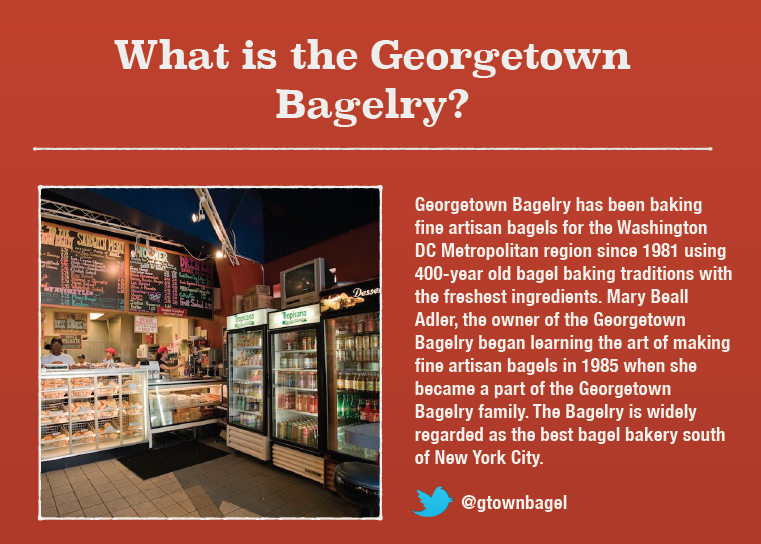In October, one of my clients and I presented at LavaCon, a digital media strategies conference in Portland. Mary Beall Adler, CEO and owner of the Georgetown Bagelry – one of my first clients -presented a case study about how her bagel shop – a fixture of the DC area – leveraged her amazing community of customers to streamline business processes and increase revenue.
Mary and I began working together in 2010. Together, our passion for community building and creative approaches to business and leadership helped the bagelry grow in new ways.
Social media has always played a strong role in Mary’s business. Once we were able to build a consistent framework so that it could be maintained and managed, we began to strategize about how we can streamline many of the business processes that plagued the bagelry.
I don’t know much about running a bagel shop, but it was definitely clear that there were ways that we could make things run more efficiently. Mary, because she lives and breathes bagels and the shop, knows these processes inside and out and is always looking to improve them.
By outlining the problems we wanted to solve, we were able to improve online [and in-store] revenue considerably.
In July of 2010, online ordering at the Georgetown Bagelry was implemented. We first started using an online ordering program called Munchaway — which served its purpose at the time. It was primarily a desktop solution — offering limited mobile functionality and was fairly rigid in its set up. But that was okay, because online ordering was a new behavior for our customers at the time.
However, over time we worked to convert and change customer behaviors to become more mobile so as to alleviate some of the in-store processes GTB struggled with.
So how did we do it?
We sat down and mapped out the different parts we want to influence or enhance — namely people, the environment and the bottom line. Obviously, they all connect in some way. Ultimately, we wanted to streamline processes so we could streamline costs while increasing revenue — but we knew that we couldn’t do that without leveraging or utilizing our community — the people who work at GTB and the people who buy from GTB.

We started with the people.
The GTB community LOVE its bagels. Georgetown Bagelry used to be located in the heart of Georgetown, but in 2007 the Bethesda shop became the primary location. GTB now sits at the end of a strip mall, next to a Whole Foods. You need to drive there. You need to park. And yet, its customers do it. Because they love its bagels. They love Mary. And they love the community that the bagelry embodies. It’s a meeting place.
GTB is so fortunate to have such a loyal following of customers, but the shop continually struggled to get customers in and out efficiently AND effectively — without disrupting the culture or upsetting the customers. We had to learn how to make GTB’s customers and the bagel experience MORE AWESOME.
We started with social. With a loyal audience already in place — and a willing and able CEO at the helm — we turned to social to educate and subtly remind customers of how they could be getting their favorite bagels — ONLINE. As well as keeping the in-store customer experience deliberate and fun!
We engaged our social audience in fun contests — that rewarded them for skipping the line and ordering ahead — as well as reasons to come into the store.

Now, when it comes to online ordering — it’s a convenience — for both the customer who orders online — and the store — who only has to give the order to the customer. At first, our vendor still made it so we had to “ring up” the customer when he came to pick up the order. While being able to prepare food in advance was helpful — there was still a bottle neck for the customer and store.
We knew our audience was still using their desktops primarily to order, so we weren’t so concerned about whether or not it was mobile friendly or not. Yet, over time our audience began to adopt mobile devices to visit our site — so we used it as an opportunity to upgrade our online ordering system to one that let us have the user order and pay online — as well as provided a mobile-friendly app and interface.
Users were still ordering from the desktop — but at least now the in-store pick up process had eased — all they needed to do was zoom to the front of the line to pick up their order — no line needed.
As we pushed them to online order more, and improved the online ordering process — the number of online orders increased, as did sales from online orders.

In January 2014 we experimented with a mobile friendly website. Yes, we know having a mobile friendly web interface is important — but based on our audience’s mobile device needs, it wasn’t a huge priority. Still, we didn’t know if our audience wasn’t more mobile because our site wasn’t or because they just didn’t think of online ordering as a mobile-experience. Using a free, customizable tool called Dudamobile — we made it so users, when on a smartphone could interact with the site more easily — online ordering was a 2-click process. Before we took on the cost of building a mobile site, we wanted to see what happened.
Mobile site performance since 2014 has grown. The site provides more than just access to online ordering — including coupons that can be used in store, updates from our blog and general news and info — which may account for increased page views.
Even while online ordering and sales increased, there was still a line outside the door — especially on weekends! Mary, simply asked why people chose to stand in line when they could order online and skip the line. What she learned is that people LIKED the line. It was an opportunity for them to catch up with their neighbors, get outside and generally just take in the atmosphere. Of course, the line still creates some workflow issues for the staff — so we’ve started experimenting with passing around an ipad so customers in line can place their orders in advanced or encouraging them to order from their own devices while in-line.

Another component to our strategy is creating a healthy environment. This is the stuff that isn’t as sexy, but is just as necessary. Are staff happy? Are they properly educated as food managers? Are they responding to trends effectively? It all makes a difference and contributes to a healthy, safe, fun place to work AND shop.

Finally — it’s all about the bottom line. Again, little things can make a big difference. From ingredients to how much flour you order at once. Tweaking these according to the trends can be instrumental to how your business is run.
It’s also about taking advantage of opportunities that give GTB more visibility in the community – GTB bagels are now available in 25 stores in and around the DC area. GTB is also very active in supplying bagels as donations for community events like 5Ks, high school events and other causes.

What we’re doing is getting noticed. In March this year, GTB was recognized by Mashable as being one of 32 small businesses killing it on social. It was awesome for GTB to be celebrated for being itself — quirky, relatable and engaging!
To summarize — while our experiences are probably individual to us — not everyone is a bagel shop — we do think there are lessons that can be applied across industries. Here are a few:
You’re only as good as our community — many of the things GTB did were possible because of the amazing customer base. If we had to spend time growing it first, this process would have taken much longer.
Take part in your community. Just like CEOs who roam the halls are more likely to be clued into the real company culture, having Mary roam around and talk to people and be the face of the company has been extremely helpful. It’s hard not to like Mary — so she’s a great ambassador — which opens doors for GTB to take part in the community. As well, getting certified as a woman-owned business helps as does being a member of the Bethesda Chamber of Commerce.
Listen and watch your customers. What are they doing? What aren’t they doing? Look at your analytics. Look at order trends. What days of the week are more active than others? What can you do to even it out or engage more people on different days?
Experiment. I love working with small businesses because they are more agile — they can easily experiment with something without having red tape or a million meetings to discuss it. You can just do it. Monitor and evolve it, as needed. You’ll know very quickly whether it’s working or not.

